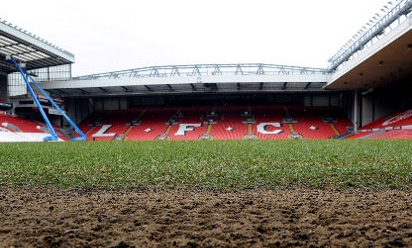How Anfield is being prepared for 2013-14
We tend to think that when the last ball of the season is kicked and the final fan has filed out of Anfield, the stadium becomes a virtual ghost town until the action resumes in the form of pre-season friendlies in July.
But in actual fact the opposite applies, as we found out when Ged Poynton, stadium manager and head of operations, invited Liverpoolfc.com down to L4 in the middle of the close-season.
Ged has been at the club for 21 years and he has found that there's more and more work to be done as the seasons go by; however, this year, the volume of work has expanded out of all proportion.

In the two weeks that followed Jamie Carragher's poignant farewell, as is customary, the hallowed Anfield turf played host to partners, sponsors, community events, Academy competitions and the Liverpool Schools Cup.
All the events at the end of the season were successful, and plenty of people were able to fulfil a dream and take the opportunity to have a run-out at the home of the Reds.
After the allotted two weeks were up the real work on Anfield swung into action - and it all began with the focal point: the pitch itself.
"We started work on the pitch on June 1," explained Ged. "Every year, like most clubs, we strip the pitch.
"We have a machine called a Koro - and that removes all the grass from the field. But first we spray the turf, four or five days before the last of the close-season events, and that makes the grass slowly die off.
"It goes very yellow. The Koro machine then strips the dead grass out. What remains underneath is something called the 'Desso Grassmaster'. This is a system - already in place - which weaves strands of grass into the pitch.
"It acts as reinforcement. So when the grass grows, the roots below the ground wrap themselves around plastic and have a firm hold there to reinforce the turf. That's why you don't see large clumps or divots, which roll up the grass.
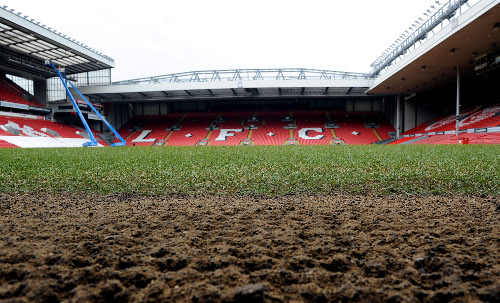
"We also apply a special material, which is like fibre sand, and it is put into the roots zone when the pitch is reconstructed.
"We've had this system in place for 15 years. It was completed in 1998 - we're ready to replace that when we can afford it in the next couple of years.
"The pitch is put to bed, re-cultivated, levelled - then it's top-dressed and re-seeded. This year, that was all done in the space of four days. Thankfully, during the time it was undertaken, there was fabulous weather.
"None of the green you see in the pictures here is grass - it's Desso. And that relates to three per cent of the total pitch area. A standard pitch is about 8,500 square metres.
"When the grass breaks through, within a week, the first cuts can take place and every other day we'll cut the grass. And every time we cut the grass a further stem will develop from the roots.
"The more you cut it, the more the grass multiplies. And the weather we have at the moment is perfect - a bit of light rain, but still a bit of warmth. There's heat, light, moisture, water and obviously oxygen in the air.
"That's great for now, but it's also why, from the end of October to sometime in March, grow lights are brought in to artificially grow the grass - like a greenhouse effect. Because in winter, after a certain stage there's no growth and there's no growth because it's too cold - below eight degrees.
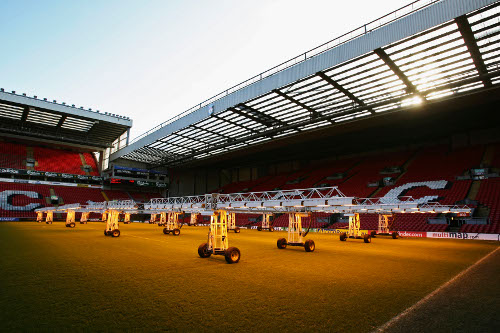
"So we like eight weeks' growing time on the pitch, but we'll only get seven-and-a-half this year before Steven Gerrard's testimonial."
Two huge cherry pickers dominate the scene out on the Anfield pitch. Parked side by side on the Centenary Stand touchline they reach up towards the roof to carry out crucial maintenance.
They are there to renovate the structural steel above and below the roof in the old Kemlyn Road stand.
Mobile platforms gradually work their way across the length of the upper tier allowing workers to clean off flaking paint and reapply a new cover, all to make sure Anfield reaches the standards and retains its safety certificate.
"That's a big job, but the biggest part was figuring out how to get the cherry pickers into the ground in the first place," continued Ged. "We had to take exit gates out of the Kop completely to get them in.
"The alternative was to crane them over the roof of the stand like we did with all the equipment for the Paul McCartney concert back in July 2008."
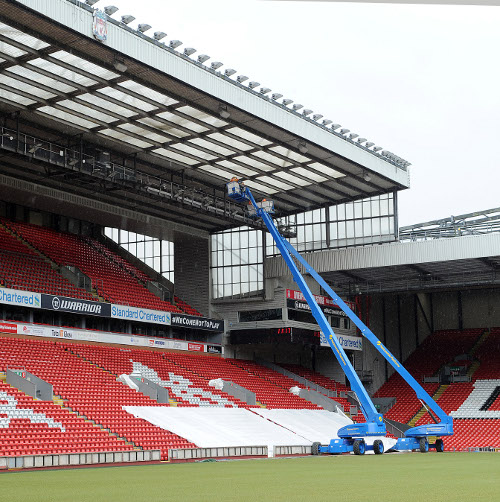
Those who enter Anfield through certain entrances in the world-famous Kop will know that full-height turnstiles are the norm - and come the start of next season, three corners of the ground will have them.
"The Anfield Road upper and lower, Centenary Stand upper and lower and the rest of the Kop will all have full-height turnstiles," said Ged.
"All the turnstiles have been taken out and replaced with these new ones. There are already some in the Kop - and our new ones will be like those, but more modern.
"That work started the day after the last game of the season. It means all the access controls have to be disconnected and replaced. So when we start the season we'll have two stands with brand-new turnstiles, upper and lower, and a renewed access controls system in the stadium."
The Main Stand reception is the first glance of the inside of Anfield that opposing teams get as they depart their coach and make for the tunnel that will lead them on to the changing rooms.
At the top of the staircase directly in front of the main glass doors is a landing area which is decorated with trophies and a notice which reminds visitors and fans alike of the club's phenomenal history.
This part of the ground is also currently enjoying a makeover of its own - and will be modernised ready for the start of the 2013-14 campaign.
"There are refurbishments and a scope of works in the Main Stand reception, staircase and top landing," continued Ged. "That work started after the two-week end of season events finished and that's due to finish by the second week in July.

"There are two lounges in the Main Stand which are being redone. The Legends lounge and the trophy room are having some smaller upgrades. The trophy cabinets are being replaced.
"There is also a small upgrade to the museum which we'll start after the school holidays in September. That will be a six-week project - a small makeover in terms of graphics and paintings."
Now for the biggest set of renovations Ged and his team will undertake over the coming months.
As of next season, a new TV deal which the Barclays Premier League has negotiated will kick in.
The implications, Ged explains, are that BT will now become the second - or joint - provider along with Sky, and overseas rights will quadruple in income.
"Because of that, every club throughout the Premier League has received a working document as to the minimum upgrades they need to provide," he explained.
"What it means is we have to provide additional TV studios for broadcasting. The studio on the fourth level of the Centenary Stand is our current studio. Box 1A below it is a lounge at the moment - that will become our second studio.
"We have to provide around 16 more camera positions, manned-positions, and we have to provide a proper integrated 3D cable system around the stadium.
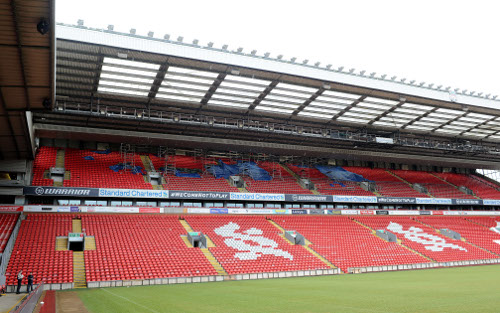
"On the face of the Centenary Stand, fans will be able to see three camera pods - the sort you see at Wembley and the Emirates, where you have an access to go over the front wall and the cameraman will sit in something like a Bosun's Chair. He sits there and films the game.
"You'll see camera positions where you've never seen them before. They'll be in place next year. Along with alterations to the main TV gantries, an additional 21 fixed commentary positions will be placed in the Main Stand.
"Fixed camera positions will be put in place on platforms at the back of the Main Stand too. The scope of works is huge. All that work will start in the next week or so.
"Every club in the Premier League has to adjust to this. In certain games next season you might see up to seven commentary positions pitchside, standing up, like you get for some of the Champions League games. They'll have to disappear 10 minutes before the game, though.
"And so to accommodate that, you have to have network points and TV links -you can imagine the whole thing will take a lot of work to implement.
"You have to have mixed zones, post-match broadcasting positions, all the extra camera positions, a larger online broadcast area, two studios minimum and also additional commentary positions. Wrap all that up and there's a major scope of works.
"There are also changes on the IT side of things - we're extending the Wi-Fi networks. We're providing connectivity right around the ground for all the commentators and so on."
On top of all this, Ged explains, all the normal close-season works need to be fulfilled - the life-saving systems like gas intake for the stadium, turnstiles, CCTV, PA systems, emergency escape route systems need to be serviced and licensed.
Then there's all the normal end of season works, like painting and redecorating toilets, replacing seats where necessary, renumbering seats and rows as and where possible.

"So if you add all that into the pot, it's like a major building site," said Ged. "But that's not too different from most seasons. It's what we would do in a normal close-season - but the new TV deal, which is a major one-off, makes it a lot busier. Most clubs will be in a similar situation.
"We're doing some small works in the food village, where we are putting more permanent units there for the family zone.
"We have things going on at Melwood and at the Academy also. If you think about all the hard work put into the pitch at Anfield, then imagine how long it will take to do the 14 at the Academy and the four which we have at Melwood.
"In between all these 10 weeks, you have your full-time staff, ground staff, maintenance staff who need to take holidays because through the season there are limited opportunities. So all this is going on as well.
"And finally, under our banner 'Reds Going Green', the company policy of trying to get our carbon footprint down, there is a continuous work towards waste management and recycling.
"And one of the big schemes we have is that we are changing lights left right and centre to LED, which are low energy.
"We've also introduced lighting sensors to the stadium for the first time - a system that controls lights on and off in toilets around the ground.
"So there's a big ongoing project in addressing the environmental issues as well, reducing our energy usage and adding more efficiency. That's a continuous process."
[SLIDESHOW]


